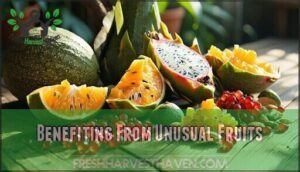This site is supported by our readers. We may earn a commission, at no cost to you, if you purchase through links.
 You can transform your garden into an exotic fruit paradise by growing unusual fruit varieties at home like dragon fruit, passion fruit, and Asian pears.
You can transform your garden into an exotic fruit paradise by growing unusual fruit varieties at home like dragon fruit, passion fruit, and Asian pears.
Start with climate-appropriate varieties—citrus trees thrive in containers for northern gardeners, while tropical fruits like guava need greenhouse protection in cooler zones.
Focus on well-draining soil, consistent watering, and proper sun exposure for each variety’s specific needs.
Most unusual fruits actually adapt better to home gardens than you’d expect, often producing fruit within 2-3 years when given the right conditions and care routine that matches their native growing environments.
Table Of Contents
- Key Takeaways
- Choosing Unusual Fruits
- Preparing Soil and Climate
- Growing Unusual Fruits
- Caring for Unusual Fruits
- Benefiting From Unusual Fruits
- Frequently Asked Questions (FAQs)
- What is the rarest fruit to grow?
- What fruits cannot be planted together?
- What is the most obscure fruit?
- What’s the most profitable fruit to grow?
- What are 5 exotic fruits?
- Is a fruit or vegetable?
- How to grow exotic fruit?
- What is the rarest fruit to get?
- What is the most profitable fruit to plant?
- What is the most unusual fruit in the world?
- Conclusion
Key Takeaways
- Start with climate-appropriate varieties – You’ll succeed faster by choosing fruits that match your growing zone, like containerized citrus for northern areas or greenhouse-protected tropical fruits for cooler climates.
- Focus on soil drainage and pH – Most unusual fruits need well-draining soil with a pH between 5.5-6.5, so test your soil first and amend it with compost to prevent root rot and nutrient deficiencies.
- Expect 2-3 years for fruit production – Don’t get discouraged while waiting for harvests, as most exotic varieties take time to establish before they’ll reward you with homegrown dragon fruit, passion fruit, or Asian pears.
- Master specific care routines – You’ll need to learn each variety’s unique watering, sunlight, and pruning requirements since exotic fruits often have different needs than typical garden crops.
Choosing Unusual Fruits
You can transform your garden into an exotic paradise by growing unusual fruits that typically thrive in far-off lands.
These seven remarkable varieties will challenge your green thumb while rewarding you with flavors you won’t find at your local grocery store.
Exotic Fruit Varieties Overview
Exotic fruits transform ordinary gardens into botanical adventures.
These unusual fruit varieties offer rare flavor profiles and striking visual appeal that captivate both novice and experienced gardeners.
Consider these exceptional options:
- Dragon Fruit – Vibrant pink exterior with speckled white flesh
- Passion Fruit – Aromatic tropical essence with tangy-sweet pulp
- Feijoa – Pineapple-guava fusion with ornamental red flowers
Each variety brings unique fruit origins and cultural significance to your homegrown harvest.
To thrive, these fruits often need well-draining sandy soil.
Rare Fruit Types for Home Growing
Looking beyond familiar fruit varieties opens doors to remarkable rare fruit trees that thrive in home gardens.
Pawpaw produces 500g tropical-flavored fruits in zones 5-8, while che fruit yields 15kg annually from mature shrubs.
Hardy kiwi vines generate 100g vitamin-packed berries perfect for temperate climates.
Jaboticaba creates grape-like clusters directly on trunk bark, fruiting twice yearly.
Finger lime contains 10mg vitamin C per "citrus caviar" pod and adapts well to containers.
These unique fruit varieties require specific fruit propagation methods and grafting techniques for ideal success, making unusual fruit growing an exciting horticultural adventure.
Climate Considerations for Unusual Fruits
Understanding Hardiness Zones sets the foundation for successful exotic fruit cultivation. Most unusual varieties need minimum winter temperatures above 10°C, though hardy options like pawpaw tolerate zones 5-9.
Microclimates Matter—strategic windbreaks and reflective mulch boost Temperature Regulation. Frost Protection through covers saves delicate plants during cold snaps.
Consider Humidity Levels and Sunlight Intensity requirements, as most exotics need 6-8 hours direct sun daily.
- Watch your plants thrive in perfectly crafted growing conditions
- Feel the satisfaction of harvesting tropical treasures in temperate climates
- Experience the joy of year-round exotic fruit production
- Discover the pride of mastering challenging climate adaptations
Preparing Soil and Climate
You’ll need to match your soil’s pH and drainage to each fruit’s specific needs, since exotic varieties can be surprisingly picky about their growing conditions.
Creating the right microclimate through strategic placement, protection, and sometimes greenhouse growing makes the difference between thriving plants and expensive disappointments, which requires understanding the importance of complete concepts.
Soil Requirements for Unusual Fruits
Growing unusual fruits requires soil pH between 5.5-6.5 for ideal nutrient absorption.
Test your soil first to identify nutrient deficiencies and drainage needs. Most exotic varieties demand well-draining soil to prevent root rot.
Boost organic matter content using compost and aged manure as soil amendments. Remember: healthy soil creates the foundation for thriving unusual fruit varieties—skip this step at your own peril!
Creating Optimal Climate Conditions
Climate control transforms your backyard into a tropical paradise. Maintain temperatures between 70-85°F using thermal masses like rocks or water features for Temperature Regulation. Boost Humidity Control with pebble trays or misting systems, targeting 50-80% levels.
Protect from harsh winds while maximizing Light Intensity through strategic placement and grow lights when natural sunlight falls short. To guarantee success, provide well-drained soil to avoid issues like root rot.
Essential climate considerations for exotic fruit success:
- Microclimates creation using walls, patios, or courtyards for heat retention
- Wind Protection through strategic barriers and shelter placement
- Sunlight exposure of 6+ hours daily with south-facing positioning
- Humidity control using trays, misters, or grouped plantings
- Microclimate creation with mulch and ground cover for stable conditions
Using Greenhouses for Tropical Fruits
Greenhouses transform impossible growing conditions into tropical paradise zones for exotic fruits.
You’ll control humidity control and temperature precisely, though heating costs can add up during winter months.
Choose compact tropical fruits like dragon fruit or passion fruit for better greenhouse design efficiency.
Pollination challenges emerge since natural pollinators can’t access enclosed spaces—you’ll hand-pollinate most blooms yourself.
Smart fruit selection focuses on varieties that thrive in controlled environments.
Adequate sunlight through glass panels and proper ventilation prevent fungal issues while maintaining ideal growing conditions year-round.
Consider ways to mitigate potential heating expenses.
Growing Unusual Fruits
Now you’re ready to turn your carefully prepared garden into a thriving home for exotic fruits.
Once you’ve planted your unusual varieties, consistent care through proper watering, strategic fertilization, and timely pruning will determine whether you’ll harvest basket loads of dragon fruit or just admire pretty vines.
Growing Unusual Fruits Introduction
Now you’re ready to turn your carefully prepared garden into a thriving home for exotic fruits.
Once you’ve planted your unusual varieties, consistent care through proper watering, strategic fertilization, and timely pruning will determine whether you’ll harvest basket loads of dragon fruit or just admire pretty vines.
Planting and Germinating Unusual Fruits
Start your exotic fruit gardening journey by mastering seed scarification and stratification methods. Use hot water soaking or mechanical scarification to break tough seed coats on passion fruit and tropical varieties.
Apply stratification methods for temperate species—30-60 days at 40°F works well. Choose propagation mediums like vermiculite for superior germination rates.
For example, with mango seeds, root emergence is key for successful planting. Try rooting cuttings in well-aerated soil, or experiment with grafting techniques for challenging varieties.
These proven planting techniques facilitate success with unusual fruits from reliable seed sources, ensuring a successful exotic fruit gardening journey with superior germination rates.
Watering and Sunlight Requirements
Understanding your exotic fruits’ watering frequency and sunlight intensity needs guarantees healthy growth.
Most unusual varieties require full sun, though some prefer partial shade. Check soil moisture daily—it should feel damp, never soggy.
Here’s your essential care checklist:
- Monitor drainage solutions to prevent waterlogged roots
- Adjust watering frequency based on seasonal temperature changes
- Observe humidity levels for tropical species like dragon fruit
- Modify sunlight requirements as plants mature and seasons shift
- Make watering adjustments during hot spells to prevent stress
Seasonal adjustments matter most—summer heat increases water needs while winter reduces them substantially.
Fertilization and Pruning Techniques
Two essential practices guarantee healthy exotic fruit trees. Nutrient timing drives success—feed during spring and summer with organic fruit tree fertilizer, then stop completely in winter. Growth habit determines your pruning styles: use thinning cuts for dense varieties like cherimoya, heading cuts for vigorous vines like passionfruit.
Proper timing is vital, especially when considering seasonal pruning practices.
| Fertilization Task | Pruning Task |
|---|---|
| Apply balanced NPK monthly | Tool sterilization between cuts |
| Test soil pH (6.0-7.0 ideal) | Fruit thinning after set |
| Foliar feed micronutrients | Remove deadwood and suckers |
| Stop feeding in dormancy | Use shaping techniques for training |
Master fruit tree fertilization and fruit tree pruning with proper pruning tools for thriving exotic harvests.
Caring for Unusual Fruits
Once your unusual fruits start producing, you’ll need to provide proper support structures and master timing for peak flavor harvests.
Training climbing varieties like dragon fruit onto trellises and knowing when each fruit reaches its sweet spot makes all the difference between disappointing crops and backyard treasures.
Training and Supporting Fruit Plants
Your unusual fruit plants need proper support systems to thrive and produce heavy fruit loads.
Trellis systems work best for climbing varieties like passion fruit and dragon fruit – think sturdy posts with wire or mesh that can handle mature weight.
Espalier techniques let you train trees flat against walls or fences, maximizing space while improving sunlight exposure.
Start training young plants early by gently guiding stems toward your support structure.
For container growing, adjustable frames adapt as plants grow taller.
Focus your pruning methods on encouraging vertical growth while maintaining good airflow between branches.
Dragon fruit cacti need strong posts since their stems get heavy with age.
Kiwiberries require horizontal wires spaced 18 inches apart for their twining habit.
Regular pruning keeps plants manageable and directs energy toward fruit production rather than excessive foliage growth.
Harvesting and Storing Unusual Fruits
In the context of fruit harvesting, timing is everything.
Watch for ripening indicators like color shifts and gentle softening—these clues mean it’s go-time for picking.
Always lift and twist each fruit instead of shaking branches, or you might end up with bruised treasures.
For storing, cool and humid conditions are your best bet to extend shelf-life.
One key is to understand ethylene production effects from other fruits.
Try these four technical tips:
- Harvest only dry fruits to avoid spreading disease.
- Use cushioned baskets and soft gloves for delicate varieties.
- Water blanch before freezing fruits for long-term storage.
- Store different types separately to prevent cross-ripening.
Check your stash every few days and remove any spoiled fruit pronto—one bad apple really can ruin the bunch.
With smart storage methods and drying techniques, you’ll enjoy your exotic harvest long after picking.
Benefiting From Unusual Fruits
You’ll discover that unusual fruits offer remarkable nutritional benefits, from dragon fruit‘s vitamin C content to goji berries’ antioxidant power.
These exotic varieties also expand your culinary possibilities and provide natural ingredients for homemade beauty treatments, leveraging their antioxidant power.
Nutritional Values and Health Benefits
Your homegrown exotic fruits deliver exceptional health benefits through their impressive vitamin content and mineral richness.
These unusual varieties contain powerful antioxidant properties and phytonutrient power that surpass common fruits.
| Fruit Type | Key Nutrients | Health Impact |
|---|---|---|
| Dragon Fruit | Vitamin C (3.5-10.6mg) | Immune system boost |
| Baobab | Vitamin C (40x oranges) | Cardiovascular support |
| Black Sapote | Potassium (330mg) | Heart health |
| Cherimoya | Fiber (3g per 100g) | Digestive wellness |
| Mangosteen | Copper, manganese | Metabolic function |
The fiber benefits from sapodillas provide 9g per fruit, while their antioxidant richness and mineral density support cellular health beyond standard produce options.
Culinary Uses and Recipes for Unusual Fruits
Your homegrown harvest can transform everyday meals into culinary adventures. These exotic fruits open doors to unique flavors that’ll surprise your taste buds and impress dinner guests.
Here are three ways to maximize your unusual fruit harvest:
- Create stunning fruit-based desserts using dragon fruit’s vibrant colors and cherimoya’s creamy texture
- Blend exotic fruit salads combining passion fruit with finger limes for unexpected flavor pairings
- Develop savory fruit dishes like jackfruit "pulled pork" or tamarillo chutneys
Experiment with fruit preserves to capture seasonal flavors year-round. For ideal flavor, consider eating seasonal produce at its peak ripeness. Try fermenting kiwiberries into tangy condiments or transforming soursop into probiotic-rich beverages. These fruit recipes showcase nature’s most unusual offerings while expanding your culinary repertoire beyond traditional cooking methods.
Cosmetic and Medicinal Applications
Your garden’s unusual fruits become nature’s pharmacy when you harness their natural skincare and medicinal applications.
These fruit-based cosmetics and medicinal fruit compounds offer powerful alternatives to commercial products.
- Dragon fruit and goji berries create effective homemade toners with their antioxidant-rich natural fruit extracts.
- Elderberry’s phytonutrients boost immunity through medicinal fruit-derived tinctures and cold-fighting remedies.
- Sea buckthorn delivers vitamin-packed oils for skincare applications and fruit-derived remedies.
Frequently Asked Questions (FAQs)
What is the rarest fruit to grow?
Like hunting for buried treasure, you’re seeking botanical gold in your backyard.
Mangosteen stands as the rarest homegrown prize—this "queen of fruits" demands perfect tropical conditions and takes decades to fruit, making it incredibly challenging to cultivate.
What fruits cannot be planted together?
You shouldn’t plant citrus trees near walnut trees because walnuts release juglone, which kills citrus roots.
Also avoid planting shallow-rooted fruits like strawberries underneath deep-rooted trees since they’ll compete for nutrients and water resources.
What is the most obscure fruit?
You’ll find miracle berry among the most obscure fruits, containing miraculin that makes sour foods taste sweet. This evergreen bush grows in warm climates and literally changes your taste perception.
What’s the most profitable fruit to grow?
You’ll find commercial berry farms most profitable since strawberries, blueberries, and blackberries command premium prices year-round. High-value crops like goji berries or finger limes offer excellent returns in smaller spaces.
What are 5 exotic fruits?
Before the telegraph connected distant lands, exotic fruits remained mysteries to most folks.
You’ll discover dragon fruit‘s vibrant pink skin, rambutan’s hairy red exterior, mangosteen’s purple shell, cherimoya’s custard-like texture, and passion fruit‘s aromatic tropical essence.
Is a fruit or vegetable?
The eggplant is botanically a fruit because it develops from a flower and contains seeds.
However, you’ll typically find it treated as a vegetable in cooking since its savory flavor pairs better with other vegetables.
How to grow exotic fruit?
Picture vibrant dragon fruit cascading from trellises and aromatic passion vines climbing your garden walls.
You’ll need warm temperatures, well-draining soil, and patience—most exotic fruits take years to establish before rewarding you with their tropical treasures.
What is the rarest fruit to get?
The rarest fruit you’ll encounter is likely the Miracle Berry, which contains miraculin that makes sour foods taste sweet.
You can grow these evergreen bushes in warm climates with acidic soil.
What is the most profitable fruit to plant?
You’ll profit most with avocados, mangos, limes, and coconuts based on commercial agriculture data.
Dragon fruit sells for premium prices in UAE supermarkets, while specialty varieties command higher returns than standard crops through direct-to-consumer sales channels.
What is the most unusual fruit in the world?
Nature’s rarest treasures hide in plain sight. The Miracle Berry stands as the world’s most unusual fruit, containing miraculin that transforms your taste buds, making sour foods taste incredibly sweet.
Conclusion
Let’s face it—growing unusual fruit varieties at home isn’t rocket science, but it does take some planning.
You’ll need to match each fruit’s needs to your climate, soil, and space.
With careful watering and sunlight, you’ll be picking dragon fruit or Asian pears before you know it.
Don’t forget, these exotic fruits often bring more nutrition and flavor than store-bought options.
So, grab your gardening gloves and let your backyard surprise you.
- https://novagreenhouses.com/blogs/learn/how-to-grow-exotic-fruits-in-your-greenhouse
- https://foodgardening.mequoda.com/daily/growing-fruits-berries/how-to-grow-tropical-fruit-plants-in-any-zone/
- https://practicalselfreliance.com/hardy-permaculture-plants/
- https://www.bbc.com/news/science-environment-62665053
- https://pmc.ncbi.nlm.nih.gov/articles/PMC10881846/










